Evaluation of a Multi-metallic Layered Composite Fuel Cladding for Improved Accident Tolerance
Info: 5458 words (22 pages) Example Dissertation Proposal
Published: 28th Jan 2022
Tagged: Engineering
Abstract
Nuclear power has proven to be a reliable, environmentally sustainable and cost-effective source of large-scale electricity. The high power density that makes nuclear power economical also makes the system susceptible to severe accidents. In this context, there are current research efforts across the world to develop an accident tolerant fuel (ATF). One of the major goals of the ATF programs worldwide is to develop new fuel cladding materials with enhanced oxidation resistance under a loss of coolant accident (LOCA). The present study aims at analyzing and evaluating one of the newest concepts for a cladding material: a multi-metallic layered composite (MMLC).
The goal of this study is to use multiscale modeling and simulation to assist in the evaluation of the MMLC concept as an ATF cladding material. The work will focus on three potential problem areas: thermal stresses that may develop within the cladding due to thermal expansion mismatch, the formation of problematic interfacial phases that could form due to interdiffusion, and stresses that may result from irradiation-induced shape change that may occur in the various layers. The research is expected to anticipate the mechanical and thermal behavior of the composite cladding including the interfacial phases under normal operating condition and during severe accident scenarios. These predictions could be imperative in designing and optimizing the MMLC concept, which could reduce the cost of nuclear power generation by enhancing performance and increasing the safety margin.
1. Introduction
The safe, reliable and economic operation of the nation’s nuclear power reactor fleet has always been a top priority for the United States’ nuclear industry. As a result, continual improvement of technology, including advanced materials and nuclear fuels, remains central to the industry’s success. Decades of research combined with continual operation have produced steady advancements in technology and yielded an extensive base of data, experience, and knowledge on light water reactor (LWR) fuel performance under both normal and accident conditions. The current nuclear power industry is based on mature technology and has an excellent safety and operational record. Except for a few extremely rare events, the current UO2 – zirconium alloy (UO2 – Zr) fuel system meets all performance and safety requirements while keeping nuclear energy an economically competitive clean-energy alternative for the United States [1]. Any new fuel concepts must be compliant with and evaluated against current design, operational, economic and safety requirements. The overall fuel cycle must also be considered, especially for concepts that represent a significant departure from the current technology.
The US commercial fleet produces electricity in LWRs using a UO2 – Zr fuel system. The design and development of any changes to this system first requires an understanding of the performance of the current state-of-the-art fuel system under the various system operating regimes. Decades of industry research and operational experience have produced an extensive database supporting the performance of LWR fuel during normal power operations and during postulated accident conditions.
The nuclear disaster at Fukushima, Japan has increased public concern about the safety of nuclear power. The main cause of this severe accident beyond the design basis was due to the failure of an emergency cooling system after a destructive tsunami, following an earthquake of unexpectedly high magnitude. Because of the loss of coolant, the temperature in the reactor core rose above 1200 °C, causing rapid oxidation of the Zircaloy cladding by high temperature steam that generated a large amount of hydrogen. This ultimately resulted in hydrogen explosions, reactor containment damage, and the release of radioactive isotopes into the environment.
Since then, the nuclear industry has recognized the necessity of further extending safety margins and strengthening the accident tolerance of light water reactors (LWRs). In this context, the innovative concept of accident-tolerant fuels (ATF) was initiated [2, 3]. One important goal of the ATF programs worldwide is to develop new fuel cladding materials with enhanced oxidation resistance under a loss of coolant accident (LOCA).
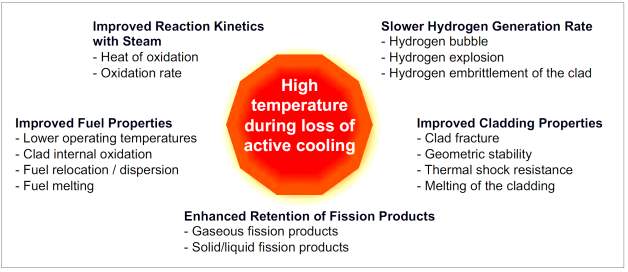
Figure 1 Major issues that need to be addressed in establishing accident-tolerant fuel attributes [3]
The development of fuels with enhanced accident tolerance necessarily begins with the definition of down-selection requirements during a concept feasibility assessment. In short, fuels with enhanced accident tolerance will tolerate the loss of active cooling in the core for a considerably longer period of time and to higher temperatures than the current fuel system while maintaining or improving fuel performance during normal operations. Figure 1 summarizes the key requirement for the advanced fuel [3].
The nuclear power industry has been developing and improving reactor technology for more than five decades and is starting to build the next generation of nuclear power reactors to fill new orders. Several generations of reactors are commonly distinguished. Generation I reactors were developed in 1950-60s, and outside the UK none are still running today [4]. Generation II reactors are typified by the present US and French fleets and most in operation elsewhere. The distinction from Generation II to the so-called Generation III (and III+) advanced reactors is arbitrary. The first are in operation in Japan and others are under construction or ready to be ordered. Generation IV designs have not gone into large scale production and there are no current plans for their construction in the US [4].
Advanced nuclear fuel and cladding must maintain, at a minimum, the level of performance and safety margin associated with the current industry standard fuel system. In this context, a research group is currently made up of researchers from MIT, Ohio State, Finland, and Penn State are working on developing a multi-metallic layered composite (MMLC) fuel cladding. The main goal of the proposed project is to develop a new, severe accident tolerant MMLC cladding to simultaneously improve LWR fuel performance and resist rare event accident scenarios.
The focus of this project is to use multiscale modeling and simulation to assist in the evaluation of the MMLC concept. Specifically, modeling and simulation will investigate phenomena that could occur due to the harsh reactor environment prior to the completion of expensive and difficult in-reactor testing. The project will focus on three potential problem areas: thermal stresses that may arise from a mismatch in the thermal expansion and thermal conductivity of the layer materials, the formation of problematic interfacial phases that could form due to interdiffusion between the layers, and stresses that may arise from irradiation-induced shape changes in the layer materials.
2. Literature Review
In this section, a detailed literature review is presented. There are four section in this discussion. Firstly, the effect of cladding materials on nuclear reactor safety is discussed, followed by the drawback of current zirconium-based alloys. In the third section, research on alternate cladding materials are explored. Finally, a new concept of multi-metallic layered composite (MMLC) cladding is examined including its advantages and drawback to bring the research questions for the present study.
a) Effect of Cladding Materials on Nuclear Reactor Safety
Figure 2 provides a general overview of core degradation processes under coolant-limited accident conditions and highlights the potential for accident tolerant fuel (ATF) cladding concepts to alter the rate of accident progression [2]. Essentially, during the first phase of the accident, core-cooling capability is lost either due to loss of water coolant due to a pipe breakage or loss of cooling capability due to pump failure. This phase can span over seconds in the case of a large-break LOCA, minutes in the case of a small break LOCA, or hours in the case of a station blackout (SBO). During this period, the decay heat in the core and the stored energy in the fuel boil off the remaining coolant in the core, subsequently driving the fuel temperature higher.
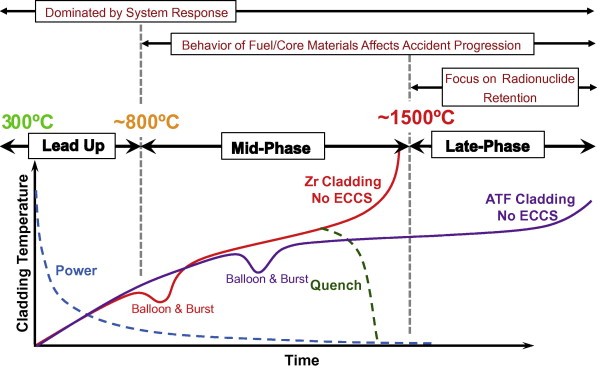
Figure 2 General overview of coolant limited accident progression inside an LWR core [2]
Once the fuel reaches temperature close to ~800 °C, a new phase in accident progression is initiated, comprising the onset of physical and chemical degradation phenomena in the core. Fuel rod burst for the current UO2 – Zr alloy fuel system is expected at temperatures ranging from 700° to 1200 °C [5], releasing a fraction of the fuel rod inventory of volatile fission products. Accelerated oxidation and detrimental interactions of the zirconium alloy fuel cladding and various other core components is also initiated during this phase.
These scenarios have been studied extensively for the current UO2 – Zr alloy fuel system [6, 7]. In case of a design-basis LOCA, once core depressurization has occurred or even before that, coolant is injected into the core and the fuel is quenched by the Emergency core cooling system (ECCS). However, if the ECCS is not operational the oxidation reaction between steam and 20 to 60 tons of Zr alloy in the core along with other reactive constituents results in the generation of appreciable amounts of heat rom oxidation that can be comparable to or even greater than the decay heat [8]. The heat generated from oxidation exacerbates the nature of the accident progression by driving the core temperature higher while increasing core-cooling requirements. Once the core temperature reaches values above ~1500 °C, severe degradation is expected to have occurred. After this point, the focus essentially shifts to radionuclide release management and protection of the larger containment structure. Hydrogen gas, the inevitable byproduct of steam oxidation, can contribute to the containment compromise through slow pressurization or explosions.
Given this general and simplified view of accident progression inside an LWR core, it becomes clear that LOCA progression and mitigation are largely dominated by the availability and nature of safety systems in place. However, it is also obvious that during the Mid-phase and thereafter for a coolant limited transient, steam oxidation along with physical degradation of core components as well as chemical interaction between the various constituents significantly exacerbated the course of accident progression. ATF concepts aim to delay the onset of these detrimental processes, thereby reducing the burdens on reactor safety systems and the operators managing the accident response.
b) Zirconium based cladding Material: Drawbacks
Zirconium alloys have been used in reactors since the early 1950s because of their low neutron cross-section and corrosion resistance in 300 °C water. They are also resistant to void swelling and have adequate mechanical properties with good thermal conductivity. Moreover, zirconium is available in large quantities and is cost-effective. However, zirconium based alloys suffer corrosion under high temperature steam, are susceptible to hydride embrittlement and have anisotropic characteristics, which lead to creep and irradiation growth.
Zirconium alloys are resistant to swelling, but not to irradiation growth and creep. The cladding undergoes a very large amount of irradiation during its life. The overall number of displacements to the cladding can be calculated with the NRT model to be G ~ 8×10-8 dpa/s, which over 3 years exposure gives eight dpa. This results in extensive atomic rearrangements and the formation of crystallographic defects. In the case of Zircaloy cladding, the primary defects are interstitial loops that form on the prism plane of the hexagonal close packed (HCP) crystal structure and vacancy loops on the basal plane. The formation of both types of loops results in a volume conserving shape change that is commonly referred to as irradiation growth.
Zirconium alloy components change shape due to several mechanisms including creep, hydride formation and free growth (Figure 3) [9]. Both temperature dependent and radiation dependent creep take place in the cladding. Hydrides also may cause size change because the hydride lattice is larger than the Zirconium lattice. 1000-ppm hydrogen can cause 0.2% dimension change [10]. Creep impact fuel performance by shrinking the gap and then conforming to the pellets (Figure 4).
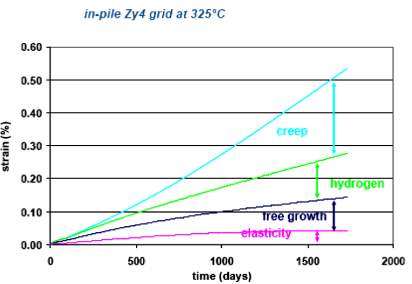
Figure 3 Zirconium alloy components shape change with time in terms of percentage strain for in-pile Zircaloy-4 grid at 325C [9]

Figure 4 Impact of fuel performance due to creep a) before “fuel-cladding” interaction, b) for a moment of “fuel-cladding” interaction, c) “fuel-cladding interaction” over most of fuel column [11]
Macroscale irrradiation growth occurs only in materials with a discrete crystallographic texture. In a polycrystalline material in which the crystal orientations are random, the growth in each grain averages out; in a material with a pronounced texture, net shape change occurs at the macroscale. A common cladding texture in which the center HCP axis is aligned in the radial direction of the cladding tube results in elongation of the cladding and thinning of the walls. Initially there is a rapid growth to small strains. Afterword, a slow growth followed by accelerated or breakaway growth caused by formation of vacancy loops on the basal plane. Irradiation growth depends on the fluence, cold-work, texture, temperature and composition. The growth increase as the hydrogen concentration increases (Figure 5). [12]
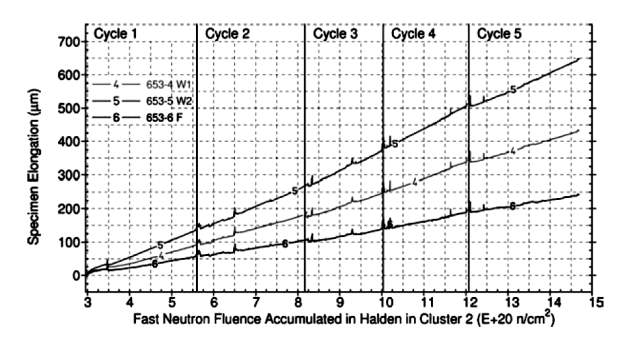
Figure 5 Specimen elongation of the cluster of 700, 260 and 135 ppm-H [12]
Under irradiation, zirconium experiences irradiation induced hardening due to interstitial loops on the prismatic planes (Figure 6). The ultimate tensile stress (UTS) goes up with fluence, while the strain before fracture goes down. Second phase particle size impact irradiation hardening (Figure 7). When stress is high enough, loops are swept away, forming a clean channel. Once a channel is cleaned out, dislocations continue to move along it. This results in deformation in that one area, creating slip steps. Those channels that do not have loops, resulting in localized deformation. Fatigue can be an issue for cladding, but there is no conclusive conclusion on the impact of irradiation on fatigue.
Zirconium cladding oxidize to form ZrO2. The oxidation is initially controlled by diffusion. Then after a protective layer forms, the process slows down. Once transition occurs, it loses its protectiveness and speeds up again. Then, the zirconium based alloy oxide recovers, reforms the protective layer, and repeats the process in cycles. The negative consequences of oxidation are: the oxide layer restricts heat transport through zirconium cladding, the metal is lost to form a brittle oxide, and hydrogen is produced in the reaction, some escaping as a gas and some entering the cladding.
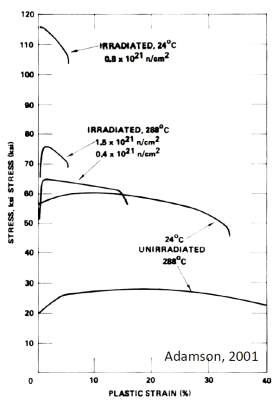
Figure 6 Stress – strain diagram for irradiated and unirradiated Zirconium alloy [13]

Figure 7 Plot of UTS versus fluence for several different Zircaloy-2 components including ultra-high fluence Zircaloy-2 plate (large SPPs) and small SPP material [14]
Hydride formation is one of the reason that corrosion of zirconium is so damaging. Some of the hydrogen atoms produced by oxidation enter the cladding and form a hydride phase. Hydrogen diffuses very quickly in zirconium, so that the hydrogen quickly spreads through the cladding. Hydrogen has a low solubility in zirconium, thus a small hydrogen concentration result in hydrides. The concentration of hydride varies with temperature and stress gradients. Hydrogen tends to move toward lower temperature and higher tensile stress. Hydrides are brittle and so reduce the ductility of the cladding.
c) Research on New Cladding materials
In 2011, following the earthquake and tsunami in Japan and the subsequent damage to the Fukushima Daiichi nuclear power plant complex, enhancing the accident tolerance of LWRs became a topic of serious discussion. Prior to the accident at Fukushima, the emphasis of advanced LWR fuel development was on improving nuclear fuel performance in terms of increased burnup for waste minimization, increased power density for power upgrades, and increased fuel reliability.
Fukushima highlighted some undesirable performance characteristics of the standard fuel system during severe accidents, including accelerated hydrogen production under certain circumstances. Thus, fuel system behavior under design-basis accident and sever-accident conditions became the primary focus for advanced fuel development, along with striving for improved performance under normal operating conditions to ensure that proposed new fuels will be economically viable. One important goal of the ATF programs worldwide is to develop new fuel cladding materials with enhanced oxidation resistance under a loss of coolant accident (LOCA).
These new concepts cover a wide spectrum of candidate materials, such as surface-modified Zircaloy [15-18] (coated with MAX phases, Cr, FeCrAl, nanostructured ferritic alloys), bulk advanced stainless steels (eg ODS steels and FeCrAl steels [19, 20], SiC/SiC (fiber) composites [21], Mo alloys [22] and multi-metallic layers composites (MMLCs) of ferritic steels on Zircaloys. They are expected to minimize oxidation, reduce subsequent hydrogen production and improve structural integrity under accidental conditions.
Coatings
In the ATF programs, a series of coating are being developed to enhance the oxidation resistance of Zircaloy exposed to high temperature steam. These coatings include Cr, SiC and MAX phases (a family of ternary carbides and nitrides). SiC and MAX phase coatings has proven to be very suitable for accelerator-driven system (ADS) applications, as both materials have limited solubility in lead-bismuth eutectic (LBE) coolant, very low neutron absorption cross sections, and in most cases can remain stable to protect the underlying steel substrate [23].
ATF programs could benefit from this technology to use it to coat SiC or MAX phase layers on T91, 316L, and 15-15Ti to test their corrosion resistance as well as liquid metal embrittlement (LME) susceptibility. As long as the coatings deal with the thermal expansion mismatch and maintain adherence to the substrate during long-term service, the corrosion resistance of these steels should be greatly improved. The LME susceptibility of T91 steel is dependent on crack initiation [24]. This indicates that damage to the coating may form a stress concentrator, which can in turn facilitate crack initiation to trigger LME at crack tips.
In this regard, coating may not fully eliminate the LME issues, and whether LME would occur in coated T91 depends on the coating adhesion and toughness. Compared to SiC, MAX phases combine the properties of ceramics and metals, likely leading to better crack initiation resistance. In this sense, MAX phases may be more suitable to serve as a relatively ductile coating than SiC, which is very brittle over a wide temperature range. In addition, MAX phases have high tolerance creep, thermal/mechanical fatigue, fracture resistance and neutron activation [25].
These impressive properties can allow MAX phase coating to be an attractive technical solution to the ATF materials issues. Nevertheless, the different swelling and creep resistance between the SiC or MAX phase coatings and the steel substrate at high doses may cause significant stresses at the interface. The brittle nature of the SiC or MAX phase coatings will not be able to accommodate the swelling and creep deformation in the substrate materials, so that these coatings may not remain intact. In this case, a buffer layer should be adopted between the coating and the substrate to mitigate this issue. Alongside with these, the fabrication of this coating is difficult which may increase the cost.
Ferritic-martensitic steels
9 to 12% Cr F/M steels have been considered as promising materials for applications in advanced nuclear systems below 600 °C, due to a combination of good mechanical properties, swelling resistance, good thermal properties etc. For instance, a modified 9Cr-Mo F/M steel (T91) has been proposed to construct the proton beam window of MYRRHA, even though intensity fluctuations of the proton beam could produce significant thermal stress. The excellent thermal conductivity of T91 is expected to better cope with this problem compared to 316L. T91 also exhibits much better radiation-induced void swelling resistance than austenitic stainless steels (Figure 8) [26], which is beneficial to reach high burnups, optimize the use of resources, and minimize the production of nuclear waste if this steel is used for fuel cladding [26].
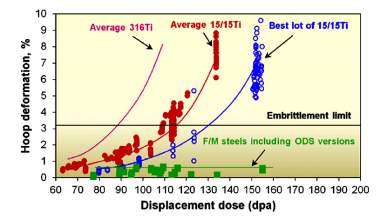
Figure 8 Maximum hoop deformation of different grades of austenitic Phoenix claddings and ferritic–martensitic materials versus dose at temperatures between 400 and 550°C [26]
The superior swelling resistance of T91 is mainly attributed to its unique, fine-grained tempered martensitic lath microstructure with copious, well-dispersed carbides and carbo-nitride, providing abundant sinks for irradiation defects. [27] From this point of view, T91 should be a preferable material for in-core structures where fast neutron fluxes are present.
Moreover, T91 is expected to show good helium embrittlement resistance under irradiation due to little contents of nickel. This steel is prone to irradiation hardening/embrittlement when irradiation temperature is below 400 °C, manifested by an increase of yield strength, a substantial decrease of uniform elongation, a drop in upper shelf energy (USE) as well as ductile brittle transition temperature (DBTT) shift to a higher temperature domain (Figure 9) [28, 29], but this phenomenon tends to be negligible when irradiation occurs at or above 400-450 °C [30]. The degradation of the tensile and impact properties after irradiation is also a sign of reduction of fracture toughness [28]. The primary limitation of T91 is that its neutron cross-section is an order of magnitude higher than that of zirconium alloys. Thus, the cladding would absorb a significant number of neutrons, decreasing the efficiency of the reactor.
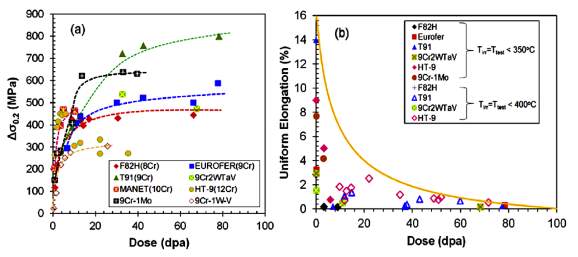
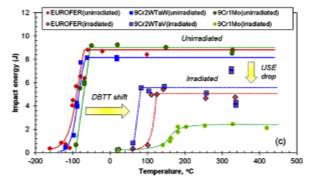

Figure 9 Irradiation effects on mechanical properties of several F/M steels: (a) yield strength versus dose at irradiation temperatures 28, 29]
Austenitic Stainless Steels
These stainless steels possess excellent overall mechanical properties and weldability. Particularly, compared to T91, they show better high temperature creep resistance (Figure 10) [31-34]. This feature is critical for fuel cladding, as the hottest spots are normally present at the fuel cladding tube wall, and the temperature at the cladding outer diameter could be higher than 550 °C. At this temperature, special attention must be paid to potential creep damage of the fuel cladding material, as well as the sudden onset of corrosion due to a lack of passivation. At roughly 55 °C, the dominant phase of iron oxide changes from magnetite (Fe3O4) to wustite (F1-xO), the latter of which is porous and brittle [35]. As with T91, austenitic stainless steels have a high neutron cross-section, compared to zirconium.

Figure 10 Stress versus rupture life (a) and creep rate versus stress (b) of 15-15Ti, 316L and T91 steels at 600 °C. [31-34]
FeCrAl alloys and Fe-Cr-Al ODS steels
FeCrAl alloys are important candidate materials for ATF applications. The corrosion resistance of these alloys has been well-tested, with preliminary results showing that a stable alumina film forms on the steel surface to effectively prevent corrosion [20]. For thermal reactors such as LWRs, the thickness of the fuel cladding must be minimized to reduce neutron absorption and thermal resistance, complicating the manufacture of thin-walled tubes. The addition of small, finely dispersed oxide particles to these alloys to form oxide dispersion strengthened (ODS) Fe-Cr-Al can greatly improve high temperature creep resistance and irradiation tolerance.
The FeCrAl alloys and their ODS version will likely be embrittled at high doses as other ferritic or F/M steels [28, 36, 37]. The FeCrAl alloys are even non-quenched and tempered (Q&T) materials, which means that the fine tempered martensite structure is absent in these alloys and thus most likely they will be subjected to high swelling. The ODS version might show better performance under the premise that fine microstructure and uniform oxide dispersion can be obtained, but mature technology for large-scale industrial fabrication is not widely available. FeCrAl alloys also have a high neutron cross-section, and would decrease reactor efficiency.
SiC/SiC (fiber) composites
Due to the combination of irradiation resistance, low radiation-induced void swelling deformation, acceptable toughness, high strength, good oxidation resistance at elevated temperatures, flexibility of fiber architecture tailoring, low thermal neutron absorption cross-section, and low neutron activation, SiC/SiC composites are promising materials not only for fusion applications, but also for fission applications [21]. In the case of fuel cladding, the tubing hermeticity is an important issue to be addressed, as the SiC matrix could crack to release fission products. In this sense, SiC/SiC or SiC coating on the surface of steel cladding tubes would be a good solution. It should not be ignored that cost, manufacturing and joining are another major issues obstructing the development of SiC fuel cladding.
Molybdenum alloys
Molybdenum (Mo) and its alloys have very high strengths at elevated temperatures (60-80 MPa at 1500 °C) and are believed to sustain fuel rod integrity and core cool-ability during an accident. However, Mo is susceptible to oxidation when exposed to an oxidizing environment, particularly at temperatures above 800 °C when volatile MoO3 is formed. In order to surpass this obstacle, FeCrAl and Zircaloy are being adopted to achieve sufficient oxidation resistance, as systematic study of which is being conducted at EPRI [22].
Nevertheless, nearly all the irradiation results showed that Mo and its alloys could be severely embrittled even at a low dose of a few to several dpa. The degradation of plasticity ability in Mo-alloys by neutron irradiation is extraordinarily steep compared with other metallic materials. This strong irradiation embrittlement sensitivity has been attributed to grain boundary weakness. Microstructural tailoring and composition optimization may be useful to strengthen grain boundaries and then mitigate the irradiation embrittlement. For instance, fine grained microstructure, ODS, minor addition of alloying elements and minimizing deleterious impurities (e.g. O) have been suggested to improve the properties of Mo and its alloys after irradiation [38]. Mo also has a high neutron cross-section and would decrease reactor efficiency.
d) Multi-metallic Layered Composite Cladding: Concepts
The composite material approach has been widely used in the nuclear industry in the manufacture of fuel cladding, where an overlay or sleeve of pure Zirconium is applied to a billet of Zircaloy and co-extruded [39]. This approach is also used in the fossil boiler industry, where high-strength, creep-resistant material is clad with an overlay of high chromium alloy [40].
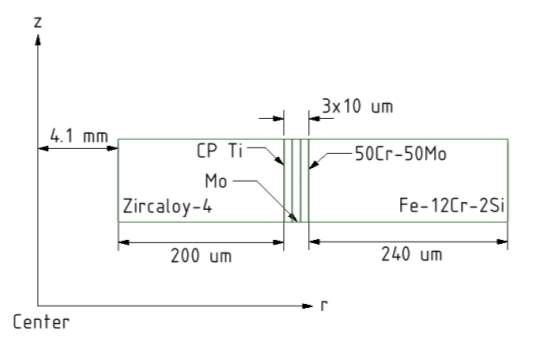
Figure 11 Proposed MMLC layers with their respective thickness (not scaled to size)
The goal of the proposed MMLCs is to enhance the performance and accident tolerance of current and future LWRs, mainly by removing as much zirconium as possible from the core without significant drops in performance. The MMLC system is composed of five layers, each of which is designed to perform specific functions unattainable by single alloys. These composites, by virtue of custom-tailored properties within each layer, should excel at:
- Maintaining microstructural stability in joints,
- Resisting combined corrosion and radiation damage at each bi-metal interface,
- Reducing the cost of key components in each reactor system.
The MMLC Fuel cladding composed of a Fe-Cr-Si alloy overlaid onto a Zircaloy base could reduce the amount of Zirconium in the reactor, resulting in less hydrogen evolution during a severe accident. In addition, a MMLC will be less susceptible to sudden, brittle failure of fuel cladding due to directional hydride formation in Zircaloys. The Zircaloy-4 is the thickest one to prevent neutronic performance. The water-facing layer of Fe-Cr-Si will resist corrosion better than Zircaloys, especially during a severe accident. The diffusion barrier layer of commercially pure Titanium is chosen to avoid the detrimental eutectic phase formation between Zirconium and Molybdenum. Similarly, molybdenum is used between Titanium and Cr – Mo as a diffusional barrier.
Cite This Work
To export a reference to this article please select a referencing stye below:
Related Services
View allRelated Content
All TagsContent relating to: "Engineering"
Engineering is the application of scientific principles and mathematics to designing and building of structures, such as bridges or buildings, roads, machines etc. and includes a range of specialised fields.
Related Articles
DMCA / Removal Request
If you are the original writer of this dissertation proposal and no longer wish to have your work published on the UKDiss.com website then please:




